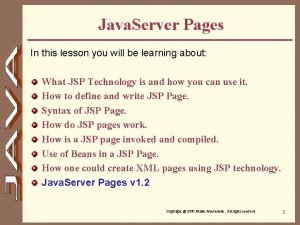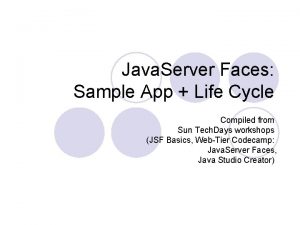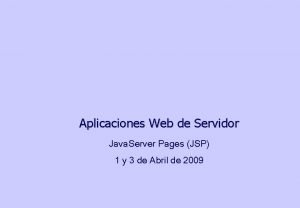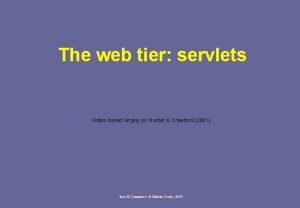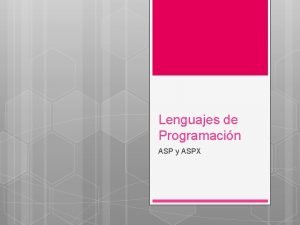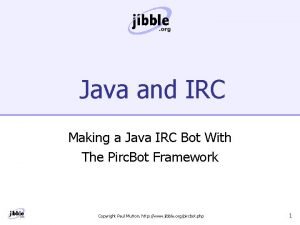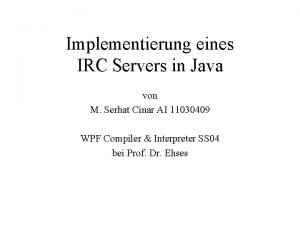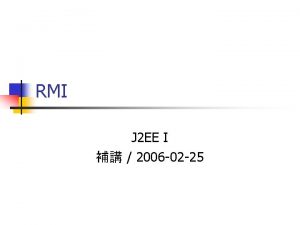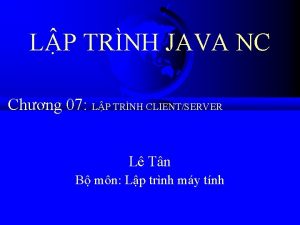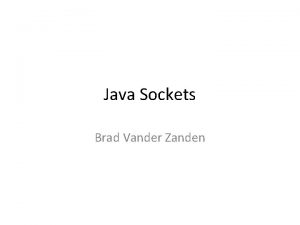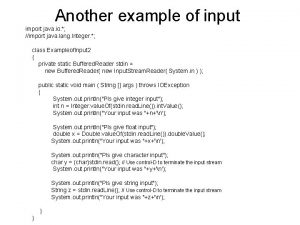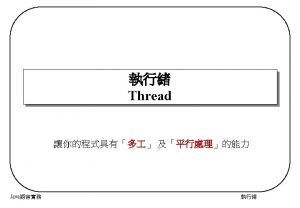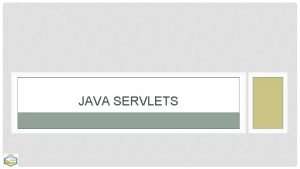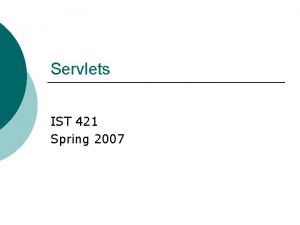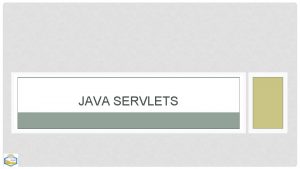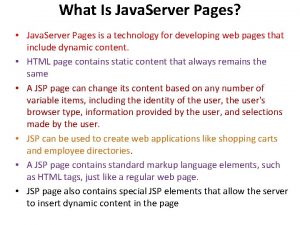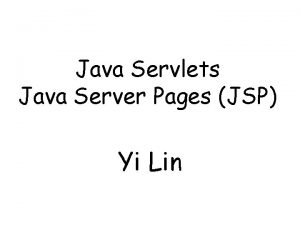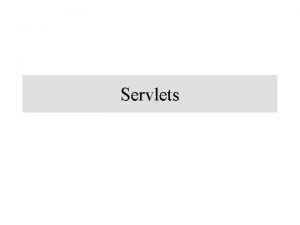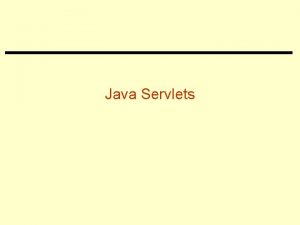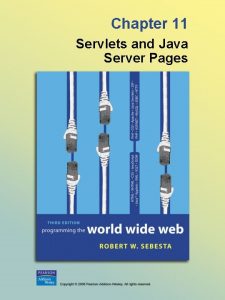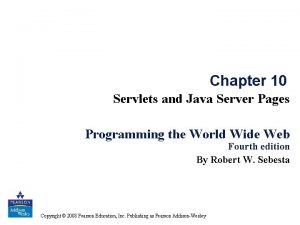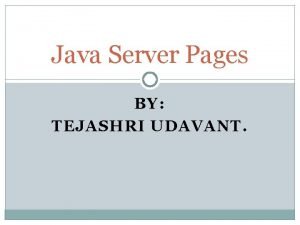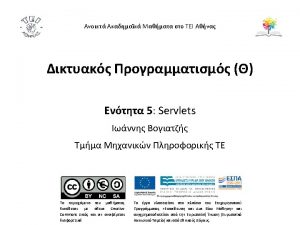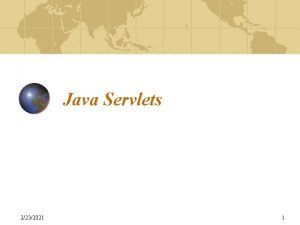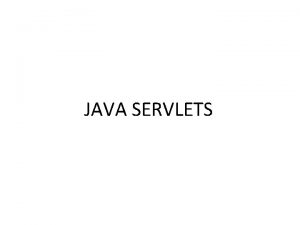Chapter 10 Servlets and Java Server Pages Copyright



























- Slides: 27

Chapter 10 Servlets and Java Server Pages Copyright © 2008 Pearson Education, Inc. Publishing as Pearson Addison-Wesley

10. 1 Overview of Servlets • A servlet is a Java class designed to be run in the context of a special servlet container • An instance of the servlet class is instantiated by the container and is used to handle requests directed to that servlet • In the most common case, servlets are used to create responses to HTTP requests Copyright © 2008 Pearson Education, Inc. Publishing as Pearson Addison-Wesley 10 -2

10. 1 Servlet Request Browser HTTP Request HTTP Response Servlet Container Response Copyright © 2008 Pearson Education, Inc. Publishing as Pearson Addison-Wesley Request object Response object Servlet 10 -3

10. 1 Servlet Advantages • Since servlets stay in existence while the server/container is running, they can remember state • Java is a more robust development language • Because the servlet stays running, it is potentially more efficient than CGI • CGI programs are started for each request • Improvements, such as mod_perl in the Apache web server, reduce much of the overhead of CGI by keeping programs in memory een between requests Copyright © 2008 Pearson Education, Inc. Publishing as Pearson Addison-Wesley 10 -4

10. 2 Servlet Details • Servlet class implement the Servlet interface • Several convenience classes are provided that implement Servlet • Generic. Servlet • Http. Servlet • Since most servlets respond to HTTP requests, the most common way to implement a servlet is to extend the Http. Servlet class Copyright © 2008 Pearson Education, Inc. Publishing as Pearson Addison-Wesley 10 -5

10. 2 Http. Servlet Details • The class provides four methods to handle different types of HTTP requests • • do. Get do. Post do. Put do. Delete • An extension class will implement one or more of these methods • Each method is called with two parameters • A request parameter containing data about the request • A response parameter that is used by the servlet to create the response • do. Get and do. Put are the only methods used in this text Copyright © 2008 Pearson Education, Inc. Publishing as Pearson Addison-Wesley 10 -6

10. 2 Responding to Http. Servlet Request • The HTTP request is mapped to a servlet by the servlet container • A configuration file provides a standard way of mapping paths to servlet classes • The Http. Servlet. Response object passed as a parameter to do. Get and do. Post provides a Print. Writer object • Output sent to the Print. Writer object will become part of the response • The Http. Servlet. Response object has a set. Content. Type method that takes the MIME type of the response as a parameter Copyright © 2008 Pearson Education, Inc. Publishing as Pearson Addison-Wesley 10 -7

10. 2 Generating a Request • As with CGI, there are two main ways of invoking a servlet • A hyperlink that specifies a path to the servlet • A form action that specifies a path to the servlet • The tst. Greet. html and Greeting. java files give a simple example in which no data is sent with the request Copyright © 2008 Pearson Education, Inc. Publishing as Pearson Addison-Wesley 10 -8

10. 3 A Survey Example • • • This example presents a simple survey Site visitors fill out a simple survey Survey results are recorded and stored in a file A summary of survey results is presented The get. Parameter method of Http. Servlet. Request is used to get the data sent from the survey form Copyright © 2008 Pearson Education, Inc. Publishing as Pearson Addison-Wesley 10 -9

10. 3 Survey Example: Race Condition • Since multiple requests may be processed at roughly the same time, some mechanism is needed to prevent the requests from interfering with each other • Such possible interference is known as a race condition • The Java synchronized clause is used to prevent multiple threads executing file access code at the same time Copyright © 2008 Pearson Education, Inc. Publishing as Pearson Addison-Wesley 10 -10

10. 4 Cookies • HTTP is a stateless protocol, that is, the server treats each request as completely separate from any other • This, however, makes some applications difficult • A shopping cart is an object that must be maintained across numerous requests and responses • The mechanism of cookies can be used to help maintain state by storing some information on the browser system • A cookie is a key/value pair that is keyed to the domain of the server • This key/value pair is sent along with any request made by the browser of the same server • A cookie has a lifetime which specifies a time at which the cookie is deleted from the browser Copyright © 2008 Pearson Education, Inc. Publishing as Pearson Addison-Wesley 10 -11

10. 4 Cookies and Security • Cookies are only returned to the server that created them • Cookies can be used to determine usage patterns that might not otherwise be ascertained by a server • Browsers generally allow users to limit how cookies are used • Browsers usually allow users to remove all cookies currently stored by the browser • Systems that depend on cookies will fail if the browser refuses to store them Copyright © 2008 Pearson Education, Inc. Publishing as Pearson Addison-Wesley 10 -12

10. 4 Servlet Support for Cookies • The Java servlet support library defines a Cookie class • Methods are provided to set the comment, set a maximum age, and set a value • Other methods retrieve data from the object • The Http. Servlet. Response object has an add. Cookie method • Cookies must be added before setting content type in the response • The Http. Servlet. Request object has a get. Cookies method that returns an array of Cookies from the request Copyright © 2008 Pearson Education, Inc. Publishing as Pearson Addison-Wesley 10 -13

10. 4 An Example • The ballot example has two components • Ballot. html has a form used to cast a vote • Vote. Counter. java defines a servlet which counts the votes for each candidate • The response page to a user casting a ballot carries a cookie. This is used to ‘mark’ a user as having voted • The vote tabulating servlet checks for the cookie and refuses to tabulate a vote if the cookie is provided with the request Copyright © 2008 Pearson Education, Inc. Publishing as Pearson Addison-Wesley 10 -14

10. 4 Session Tracking • In the Java servlet framework, sessions are sets of key/value pairs • The Http. Session object implements a session • Several methods are provided to manipulate values • • put. Value defines a key/value pair Invalidate destroys the session remove. Value removes a key/value pair get. Value retrieves a value given the key • A session object, if defined, is attached to the request object • The programmer can access the object • The programmer can specify on access that the session be created if it does not yet exist • An alternate vote counting servlet uses sessions to check for duplicate voting Copyright © 2008 Pearson Education, Inc. Publishing as Pearson Addison-Wesley 10 -15

10. 5 Java Server Pages • Java Server Pages (JSP) provide a way of embedding active content in a web page • Servlet containers manage JSP’s also • A Java Server Page is first converted to a servlet which is then operates as previously described Copyright © 2008 Pearson Education, Inc. Publishing as Pearson Addison-Wesley 10 -16

10. 5 Motivations for JSP • Creating HTML documents using println is tedious and error prone • Separation of coding and web page development can be more efficient for a team of developers • On the other hand, if there is too much code embedded in the web page, the reverse problem arises Copyright © 2008 Pearson Education, Inc. Publishing as Pearson Addison-Wesley 10 -17

10. 5 JSP Documents • JSP documents can be created in two different ways • The classic syntax uses specially formatted tags, generally starting with <% • The newer XML syntax uses valid XML • JSP documents contain four kinds of elements • • XHTML code, called template text Action elements Directives Scriptlets • Template text is passed through to the response unchanged Copyright © 2008 Pearson Education, Inc. Publishing as Pearson Addison-Wesley 10 -18

10. 5 Action Elements • Action elements create content • There are three categories of action elements • Standard action elements • Custom action elements • JSP Standard Tag LIbrar (JSTL) elements • Standard action elements are defined by the JSP standard and include basic services such as element generation and file inclusion • Custom action elements are defined by creating Java code • The JSTL is a collection of custom tags that provide important utilities Copyright © 2008 Pearson Education, Inc. Publishing as Pearson Addison-Wesley 10 -19

10. 5 JSTL • The JSTL contains five sub-libraries • • • Core tags XML Processing Internationalization and formatting Database access Functions • JSTL also supports an expression language Copyright © 2008 Pearson Education, Inc. Publishing as Pearson Addison-Wesley 10 -20

10. 5 Directives • Directives are tags that begin with <%@ • Directives define the environment in which the JSP is interpreted • A page directive provides information such as content type • The taglib directive is used to make libraries of custom tags available to the JSP • JSTL tags must be imported with a taglib directive <%@ taglib prefix=“c” uri=“http: //java. sun. com/jsp/jstl/core”%> • Is used to allow the current JSP refer to the JSTL core library • Tags from that library will use the c: qualifier Copyright © 2008 Pearson Education, Inc. Publishing as Pearson Addison-Wesley 10 -21

10. 5 Scriptlets • Scriptlets allow embedding programming language code into a JSP • Although extensions can be used to support other languages, Java is the one that must be supported • The expression scriptlet <%= expression %> Causes the value of the expression be put into the response • General Java code can be enclosed within <% … %> • JSP comments <%-- … --%> are not put into the response • Regular HTML comments <!-- … --> are put into the response Copyright © 2008 Pearson Education, Inc. Publishing as Pearson Addison-Wesley 10 -22

10. 5 Temperature Conversion Example • tempconvert 0. html and temconvert 0. jsp provide a temperature conversion example • Tempconvert 1. jsp is similar but both pages are integrated into the same JSP • A Java if is used to conditionally include content in the response • If the request comes with a data value with key ctemp, it is assumed that this is a request from the form • Otherwise, it is assumed that this is the first request and only the form is sent Copyright © 2008 Pearson Education, Inc. Publishing as Pearson Addison-Wesley 10 -23

10. 5 Expression Language • The JSTL expression language (EL) uses ${. . } to indicate an expression • The expression language includes standard operators • In some cases alternate names are provided to avoid problems with the HTML special characters • So, ge is provided as a synonym for >= • The param object is predefined in EL to provide data submitted with an HTTP request • ${param. name} gets the value associated with name • ${param[‘fancy name’]} gets the value if the name is not a proper identifier • It is usually best to use the JSTL core tag c: out to put the value of an expression into the response • Tempconvert 2. html and tempconvert 2. jsp implement temperature conversion using EL Copyright © 2008 Pearson Education, Inc. Publishing as Pearson Addison-Wesley 10 -24

10. 5 JSTL Control Action Elements • The JSTL core library defines a number of control structures • The c: if tag defines a one way branch, no else is allowed • Tempconvert 3. jsp uses the c: if tag to determine if the request being sent uses the POST method or not • If the POST method is used, it must be a form submission, so data is accessed and the conversion is carried out • If the GET method is used, this must be a first request for the page, so the form itself is returned Copyright © 2008 Pearson Education, Inc. Publishing as Pearson Addison-Wesley 10 -25

10. 5 JST foreach • The c: foreach tag provides iteration • Iteration through a list of values is supported • Iterations through a sequence of numeric values is supported • If, for example, several checkboxes have the same name attribute, the value of parm. Values. name will be a list of the values <c: foreach items=“${param. Values. name}” var=“x”> • Will step the variable x through each value in the list Copyright © 2008 Pearson Education, Inc. Publishing as Pearson Addison-Wesley 10 -26

10. 5 JSTL choose • The c: choose tag provides a multi-way choice • The testradio. jsp example uses c: if to determine the method of the request • If the method is POST, the JSP uses the c: choose construct to determine which text to put into the response Copyright © 2008 Pearson Education, Inc. Publishing as Pearson Addison-Wesley 10 -27
 What is jsp file
What is jsp file Jsf sample
Jsf sample Java server pages
Java server pages Java server pages
Java server pages O que e jsp
O que e jsp Printed pages vs web pages
Printed pages vs web pages Core servlets
Core servlets Servlets notes
Servlets notes Active server pages paradigma
Active server pages paradigma Pircbot
Pircbot Java irc
Java irc Application
Application Java.rmi.server.codebase
Java.rmi.server.codebase Lập trình socket giao tiếp tcp client/server java
Lập trình socket giao tiếp tcp client/server java Knock knock server java
Knock knock server java Pages 294 and 295
Pages 294 and 295 A process is busy swapping pages in and out. *
A process is busy swapping pages in and out. * Import java.lang.*
Import java.lang.* Java import java.util.*
Java import java.util.* Import java.applet.applet
Import java.applet.applet Java import java.io.*
Java import java.io.* Import java.util.*
Import java.util.* Import java.util.*
Import java.util.* Java import java.util.*
Java import java.util.* Import java.io.* in java
Import java.io.* in java Import java.util.*
Import java.util.* Java thread import
Java thread import Perbedaan java swing dan awt
Perbedaan java swing dan awt
